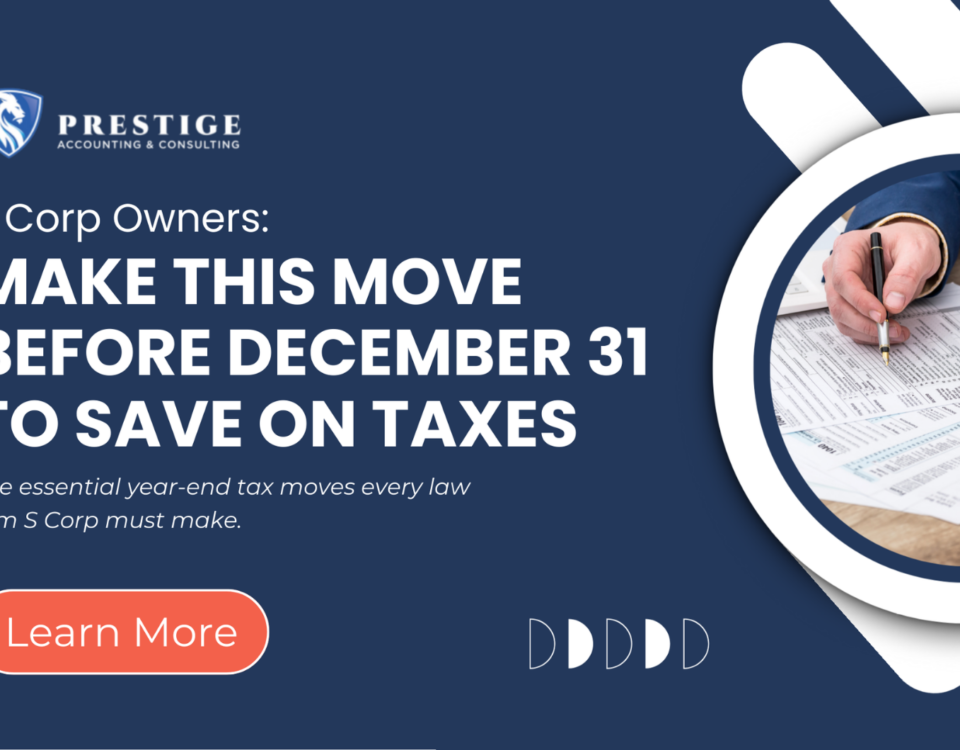
What to Do Now to Avoid a Big Tax Bill in Q4
July 8, 2025
How to Forecast Profit and Distributions for the Rest of the Year
July 15, 2025
Categories
Are You Overpaying Quarterly Taxes? Here’s How to Know
Attorneys are trained to argue the facts—but when it comes to quarterly taxes, too many rely on fiction.
We see it all the time: a law firm owner sends large estimated tax payments every quarter “just to be safe,” only to discover they’ve overpaid the IRS by thousands. That money could’ve been used to grow the firm, invest in marketing, or fund their retirement—but instead, it sat in government hands as an interest-free loan.
On the flip side, some lawyers underpay because they use last year’s income as a guide—even though their firm has grown, their expenses have changed, or their structure has shifted.
Here’s the truth: Quarterly tax payments should be based on current profitability—not outdated guesses or gut feelings.
Let’s walk through how to calculate your estimated payments accurately, avoid penalties, and stop leaving money on the table.
Why Most Lawyers Get Quarterly Estimates Wrong
The IRS expects self-employed professionals—including solo and small firm lawyers—to pay taxes throughout the year, not just at the end. That’s where estimated taxes come in.
But law firms are unique. Your revenue fluctuates. Some clients pay up front, others on contingency. Expenses shift with hiring and growth. So the “safe” estimate you made in January may be wildly inaccurate by July.
Here’s what happens when that estimate is off:
- If you overpay, your firm loses valuable working capital and your cash flow suffers.
- If you underpay, you’ll owe a surprise tax bill in Q4—plus potential penalties and interest.
The solution? Quarterly estimates based on real-time data.
The Basic Formula for Calculating Quarterly Taxes
This is a simplified framework to get a rough estimate. Your specific numbers will vary based on your entity type, deductions, and state tax obligations.
Step 1: Determine Year-to-Date (YTD) Net Profit
Pull your profit and loss statement (P&L) from January 1 to the current date. This shows your net income—revenue minus expenses.
Let’s say your net profit is $100,000 halfway through the year.
Step 2: Project Full-Year Profit
If your profit is relatively consistent, double the YTD profit. In this case, you’d project $200,000 for the year.
If your firm is seasonal, adjust accordingly.
Step 3: Estimate Your Tax Rate
As a rough baseline, use:
- 30%–35% for most solo practitioners or S-Corp owners
- This includes federal income tax, self-employment tax, and possibly state income tax
(Disclaimer: This is a general range. Your effective rate may be lower or higher.)
So: $200,000 × 33% = $66,000 total estimated tax
Step 4: Divide into Quarterly Payments
If you haven’t made any payments yet, divide $66,000 by 4 = $16,500 per quarter.
If it’s already Q3, calculate what you should have paid by now and catch up as needed.
Adjusting for Entity Type
Your entity type affects how taxes are calculated and paid:
- S-Corps must pay the owner a reasonable salary (W-2), and estimated tax payments may apply to distributions.
- LLCs or sole proprietors pay estimated taxes based on full net income (profit after expenses).
- Partnerships pass through income to partners, each of whom is responsible for their own payments.
If you’re not sure how your firm is structured—or how to handle multi-member tax obligations—this is a critical reason to get professional guidance before your next payment is due.
Real-World CPA Tip: Don’t Rely on Last Year’s Tax Return
One of the biggest mistakes we see: lawyers pulling numbers from their 2023 return and assuming it applies to 2024.
But what if:
- You raised your rates?
- You hired a staff member?
- You moved offices or started offering flat fees?
- You had a lull in Q1 and a surge in Q2?
Your tax obligations shift with your actual performance.
Only by reviewing your books—real numbers, not last year’s forms—can you confidently determine what you owe now.
Using Bookkeeping Tools and Reports to Help
If your bookkeeping is current, tools like QuickBooks or Clio Manage can generate your YTD reports in minutes. You’ll need:
- Profit & loss (P&L)
- Owner distributions
- Payroll (if applicable)
- Expense detail
This allows you—or your CPA—to run an updated tax projection for Q3 and Q4 with accuracy.
If your books aren’t current, that’s a bigger problem. You can’t make accurate tax decisions with missing or messy data. In this case, the priority is a bookkeeping catch-up before trying to recalculate anything.
What If You Overpaid Already?
If you discover that your Q1 and Q2 payments were too high, you can:
- Reduce your Q3 and Q4 payments
- Allocate excess cash toward tax-deductible expenses
- Set aside funds for retirement contributions to maximize deductions
It’s your money—don’t let the IRS hold it without a reason.
Final Word: Don’t Let Quarterly Taxes Be a Guessing Game
Paying estimated taxes isn’t optional—but guessing them doesn’t have to be your only option.
The IRS doesn’t expect perfection. They expect consistency and effort to match your real income. That means reviewing your books at mid-year, making informed adjustments, and using expert insight to keep your firm financially safe.
Most importantly, it means recognizing that good tax planning isn’t reactive—it’s strategic.
Book Your Free Tax Estimate Review
At Prestige Accounting and Consulting, we specialize in helping lawyers:
- Recalculate estimated taxes based on actual profit
- Adjust payments to avoid over- or underpaying
- Clean up and catch up bookkeeping to support tax decisions
- Build a smarter pay structure for S-Corp and LLC owners
Let’s run the real numbers and help you finish the year with clarity, not stress.





